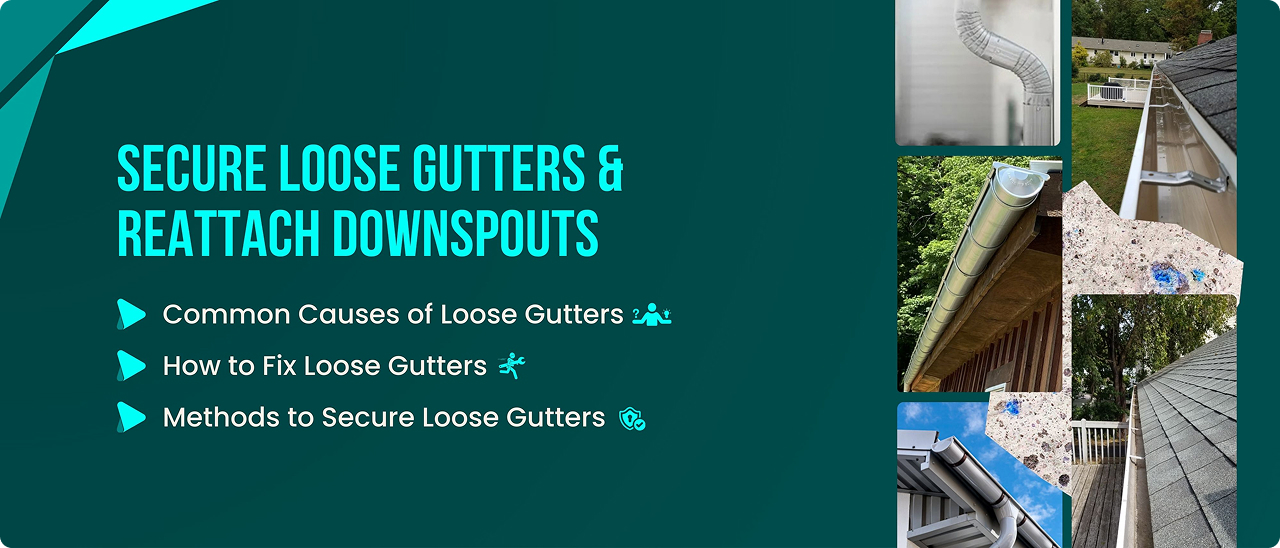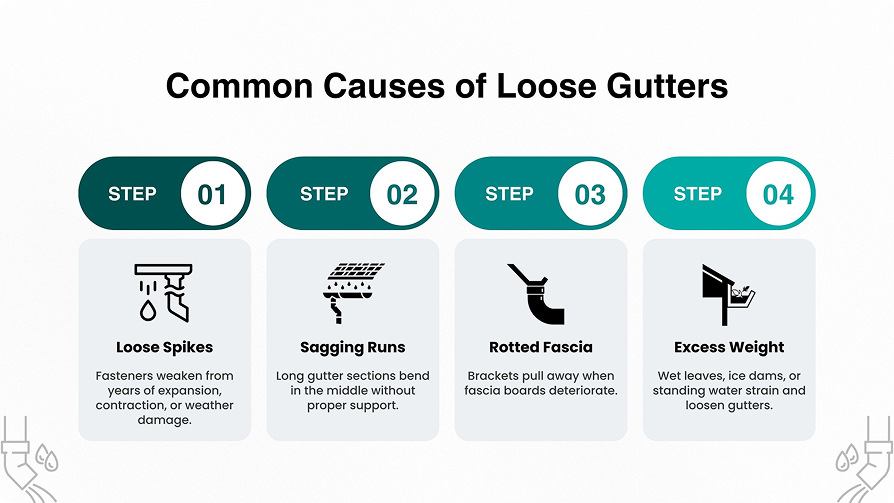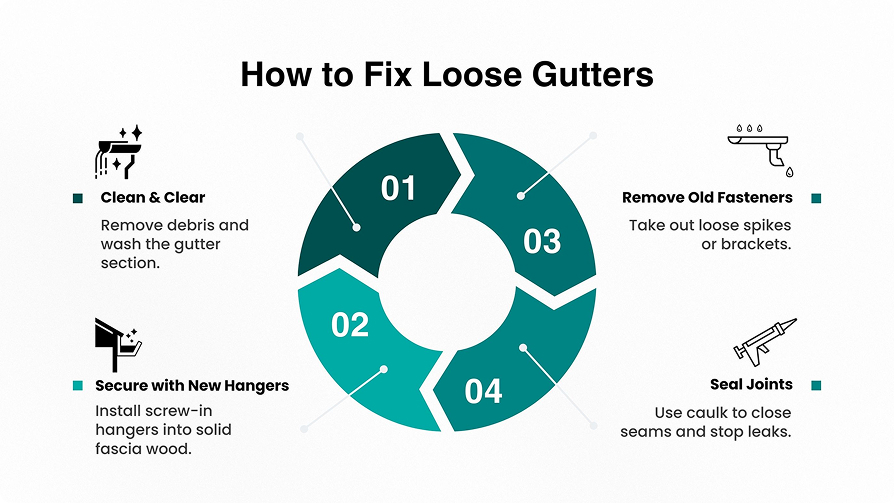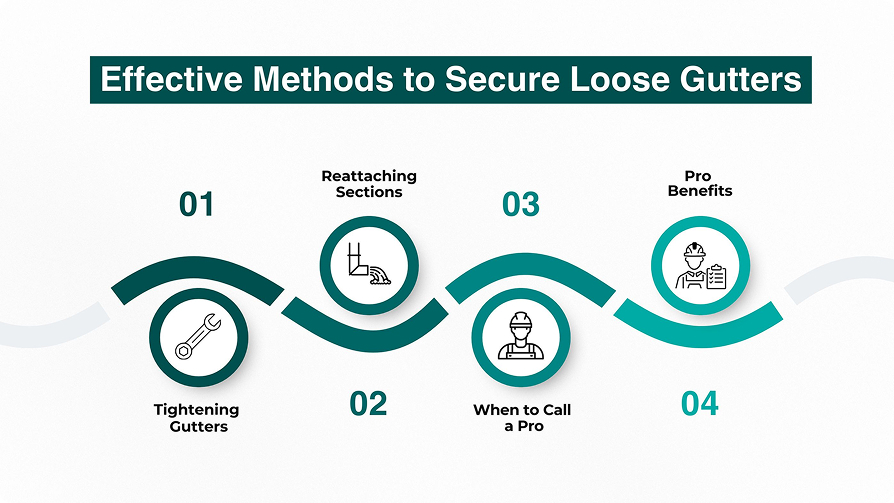Explore All
BROWSE BY CATEGORY
Interior
Exterior
Home Essentials
Homeowner Tools
Blogs & Guides
Find a Pro
Book Your Appointment Now
Home Essentials
About Renovize Home
Explore All
BROWSE BY CATEGORY
Interior
Exterior
Home Essentials
Homeowner Tools
Blogs & Guides
Find a Pro
Book Your Appointment Now
Home Essentials
About Renovize Home
Last Updated on September 28, 2025
Loose gutters are one of those home issues that often get overlooked until they start causing bigger problems. Over time, gutters can shift, sag, or detach from the house, leading to water damage, soil erosion, and even foundation cracks. Securing loose gutters and reattaching downspouts properly can save you from costly repairs and protect your home’s structure.
Here you’ll learn the common causes of loose gutters, practical DIY methods, when to call in professional gutter repair, and long-term maintenance tips for keeping downspouts secure.

Table of Contents
Common Causes of Loose Gutters
How to Fix Loose Gutters
Effective Methods to Secure Loose Gutters
Benefits of Properly Secured Gutters
Maintaining Gutter Stability for the Long Term
Final Thoughts
There are several reasons gutters can become loose. Sometimes, it’s just the result of age, but other times it’s the buildup of debris, bad installation, or even poor weather conditions. Over time, gutters can start to loosen and detach from the house, a problem that can affect almost any home.

Here are some of the most common causes for loose gutters:
When gutters are loose, water isn’t able to flow properly, causing potential damage to your siding, foundation, and landscaping.
Fixing loose gutters depends on the severity of the issue. For minor repairs, a few simple tools might do the trick. However, in more serious cases, you might need to call a professional.

If you’re dealing with loose rain gutters, the first step is to clear any debris and clean the area. Then, you can:
Once you’ve secured everything, check that water flows properly by running some through the gutter. This ensures the repair holds and the system is working as it should.
Sometimes the issue isn’t that the gutters are loose, but that they aren’t pitched properly. If your gutters are unlevel, re-pitching may be necessary. Here’s how to get your gutters back on track:
Getting the right slope for your gutters is essential for preventing water buildup and ensuring proper drainage.
Effective methods to secure loose gutters start with tightening and reinforcing any sagging sections. Replace old spikes with screw-in hangers, add extra brackets every few feet, and make sure fasteners are secured into solid fascia boards. For sections that have detached, reattach gutters carefully, sealing any joints with caulk to prevent leaks and adding splash guards at corners if needed. Checking the slope and alignment ensures water flows properly and prevents future sagging. For larger or hard-to-reach areas, professional gutter repair can provide safe, durable solutions and proper gutter reattachment tips.

When tightening loose gutters, start by replacing old spikes with hidden screw-in hangers. This will give you a more secure hold. Adding extra brackets every 2–3 feet will further stabilize the gutter and prevent sagging. Use stainless steel screws for extra durability, and check that the slope is correct after tightening everything down.
If a section has completely detached, you’ll need to reattach loose gutters by:
These steps will help stabilize sagging or detached sections, keeping your gutters secure and working properly.
Sometimes, the job may be more than a DIY project. If the damage is extensive or involves high areas, it’s best to hire a professional. Professional gutter repair experts not only know how to reattach gutters securely, but they also ensure everything is properly aligned, and water flows smoothly.
Provides a warranty on the work, so you’re covered.
Compare costs and benefits to make the right choice. Professional repairs often prevent future issues and save money long-term.
Keeping your gutters properly fastened is an investment that pays off. Secure gutters are important for preventing water damage, protecting your landscaping, and reducing future repair costs.
Here’s how properly secured gutters protect your property:
Help with gutter water management, keeping rainwater from flooding your yard and gardens.
Well-secured gutters:
Extend gutter lifespan, reducing the need for expensive replacements.
Once your gutters are secure, ongoing care is key to keeping them functioning properly and preventing future problems. Regular maintenance helps avoid sagging, leaks, and water damage to your home’s foundation, siding, and landscaping. Establishing a routine ensures that small issues are addressed before they turn into costly repairs, prolonging the lifespan of your gutter system and downspouts.
Regular checks will prevent future issues. Make sure to:
Schedule inspections every year to ensure your gutters stay in good shape.
Keep these tools on hand to make quick repairs:
Cost Breakdown: DIY vs Professional Repair
| Service | DIY Supplies | Pro Average Cost (USD) | Details |
|---|---|---|---|
| Replacing hangers/brackets | $15–$40 | $75 – $150 | Securing sections with new fasteners |
| Re-pitching gutters | $20–$60 | $150 – $300 | Adjusting slope to restore flow |
| Replacing loose downspouts | $25–$50 | $150 – $600 | Includes brackets and extensions |
| Full gutter reattachment | $40–$100 | $300 – $700+ | Stabilizing and securing multiple runs |
| Full gutter replacement | N/A | $2,000 – $6,600+ | New system including disposal and install |
Yes, loose gutters can back up water under your shingles, leading to roof leaks and rot. Fixing them early prevents expensive roof repairs.
Always use a sturdy extension ladder on level ground, wear non-slip shoes, and have someone spot you. For second-story work, professional help is the safest choice.
Yes. Seamless gutters use fewer joints and fasteners, meaning they’re less likely to sag or detach compared to sectional systems.
High winds alone rarely detach gutters, but when combined with clogged debris or weak fasteners, they can accelerate loosening and sagging.
Yes, gutter guards reduce debris buildup, which lowers water weight and strain on fasteners, helping gutters stay secure longer.
If the wood fascia is rotted or soft, new fasteners won’t hold. Replacing the fascia board is often the only long-term solution.
You can reattach them in winter if safety allows, but sealants and adhesives may not cure properly in freezing temperatures. Spring repairs are often more effective.
Securing loose gutters is about more than just cleaning up the appearance of your home. It’s about protecting your property from water damage, foundation problems, and future repair costs.By understanding why gutters come loose, knowing how to fix loose gutters, and reattaching loose gutters properly, you can keep everything in good working order. For smaller issues, a few brackets, screws, and sealant for joints will usually do the trick. But if you’re facing multiple problems or feel unsafe doing it yourself, don’t hesitate to call for professional gutter repair. Fixing the problem now will save you time, money, and stress later on.
Join our mailing list for exclusive updates, expert tips, and special offers tailored to your needs. Be the first to know about the latest in home services.


Renovize Home is a platform that supports homeowners from planning to renovation. Whether it’s Renovize AI for guidance or a one-on-one call with Pro Finder, we understand your project and match you with local contractors tailored to your needs.
Who We Are
About Renovize HomeGet in TouchHomeownwer Support:
Coming Soon!
General Inquiries:
support@renovizehome.com
Head Office:
24 Greenway Plaza, STE 1800M, Houston, TX 77046.